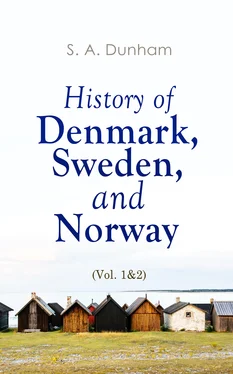We now approach historic ground. Egil Auniff , the next king of the Goths, is, beyond all doubt, Egil, the son of Aun, whose exploits we have recorded in a former page of this chapter. [150]Those exploits are the same, both in the narration of Snorro, and in that of later historians of the country: the cause and the result were the same. Egil, therefore, was king of the Goths and the Swedes. The Gothar of the Swedish writers, the successor of Egil, is also the Ottar of Snorro: the circumstances of their lives are identical. [151] Adel is the Adils , Ostan the Eystein , of the Heimskringla: in both histories, as the former was killed by the fall of his horse, so the latter was burned to death. [152]The only difference in the relation is the circumstance that led to the death of Eystein; the Norwegian authority attributing it to Solve, a Jutish pirate; the Swedish, to the rebellion of a Gothland chief. The Ingvar of the Swedish writers is indisputably the Yngvar of Snorro; and the Asmund of the former is the Onund , or Braut-Onund of the latter. In this latter reign, we perceive the same encouragement of industry; but the death of the king is variously related. Snorro, as we have before related, attributes it to an avalanche [153]; but the Swedish writers make him fall in battle against a body of rebels. Of the two next rulers mentioned by the Swedish writers— Siward and Hirvt —we have no mention in the annals of the Ynglings. The reason is, that they were kings of Gothland only, and, probably, dependent on the monarchs of Upsal: the latter, indeed, is expressly called the king of the Goths. Ingel , the next sovereign in the Swedish annals, is, beyond all doubt, the Ingiald Illrada of Snorro Sturleson, who was king of the Goths and the Swedes: his exploits, and tragical death, are the same. [154]
We have thus brought down the contemporary monarchy of the Goths, from the century before Christ to the conquest of Sweden by Ivar Vidfadme, in or about the year 623. By regarding these dynasties as separate, and endeavouring to distinguish kings whom all preceding historians have confounded, we have made the subject intelligible to the reader. The path, in which we have been the first to venture, will, we have no doubt, be traversed by other writers, until it is as well known as any other part of ancient Scandinavian history. It is yet a dark one; and criticism, aided by an extensive use of manuscript authorities, can alone enlighten it.
|623 to 794.|
The four next monarchs of the Swedes and the Goths were also kings of the Danes. Of these, Ivar Vidfadme , the conqueror of Ingiald Illrada, was one of the most celebrated. The saga relates of him that he subdued all Sweden, which he joined with Denmark; a great part of Saxland, all Estland, and a fifth part of England. There is, doubtless, some exaggeration in this statement; but this very exaggeration establishes the fact of his conquests. The part of England to which the saga alludes, is said to be Northumbria. No mention, indeed, of such a descent is to be found in the Saxon chronicle, or in Bede; and the silence of this Northumbrian historian, especially, may be a strong argument against its truth. Still, in the troubled state of the times, while the Saxons were struggling with the native Britons for the possession of the territory, the arrival of a new chief might well be overlooked, especially if the conquests of Ivar were confined to that part of Northumbria which lies north of the Tweed. It could not well be south of that river in the time of St. Oswald. But, whether this prince was in England, or not, no doubt can be entertained of his courage. His hereditary domain comprehended Scania only; Jutland he soon added to the rest; but we have no proof that he ever sat on the throne of Ledra. As king of Gothland and Sweden, however, without including his conquests on the coasts of the Baltic, he was a powerful monarch. “From him,” says Snorro, “henceforth descend the kings of the Danes and the Swedes.” On his death, the sceptre of these states was inherited by Harald , his grandson, surnamed Hildetand , or the Golden-toothed. This monarch far exceeded the former in glory. He appears, from the relation of Saxo, to have had some trouble with the Goths, and also with the Swedes; and for his success over them he was, according to the same veracious authority, indebted to the councils of Odin, who honoured him with a personal interview. From several passages in this historian, and in the sagas of a later age, we may infer that the Goths, dissatisfied at once with the Danes and the Swedes, repeatedly proclaimed their independence. They belonged not to the divine race of Odin; and the freedom which their ancestors had enjoyed before the arrival of “that wizard king,” was often the stimulant to bold deeds. As they had revolted from the Swedes, so they were equally troublesome to the Danes during the four reigns which are now before us. But Harald triumphed, and governed both nations through his royal kinsman. Other parts of the world witnessed his valour: but it was his fate to die in battle, and in his old age, against his nephew Sigurd Ring, who wished to expel him from the throne of Denmark. In the north of Europe, the battle of Bravalla is celebrated as any in ancient or modern times. Saxo, with much care, enumerates the royal chiefs who fought on both sides; but their number, no less than that of the common men, exceeds all belief. The aged and blind Harald was carried about in a war chariot; and, from time to time, he inquired how the battle proceeded. Above all, he was struck with the admirable manner in which Sigurd Ring had drawn up the hostile ranks; and he expressed his conviction that this arrangement was not the result of mortal science, but of Odin’s peculiar favour. The charioteer whom he addressed was no other than Odin, under the form of a Danish chief; and, by the hands of that deity, he received a deadly blow, and was thrown on the ground. According to Saxo, he was succeeded by Olo and Omund , in succession; but the Icelandic authorities, who make the conqueror Sigurd , or Siward Ring , his successor, are more entitled to credit. Probably Olo and Omund were viceroys only, though they might be of royal origin. Many, according to Saxo, were the kings who intervened between Harald Hildetand and Ragnar Lodbrog ; while the more critical historians of modern times, supported by Icelandic authorities, pass at once from the one to the other. At this distance, and without the aid of documents clearer than any that have yet been published, it is impossible to say which of the lists is the true one: but the probabilities are in favour of the Icelanders; for, though the kings enumerated by Saxo may have ruled in some parts of Denmark, they were, it is believed, rather viceroys than monarchs. By means of local governors, indeed, the four princes whose names fill this paragraph must have reigned; their states were too numerous, too extensive, for personal superintendence, especially when, as was generally the case, they were absent on foreign expeditions. To the exploits of Ragnar we have scarcely alluded, even in the Danish portion of the history; the reason is, that we can see in them little which is consentaneous with truth—little which is not a monstrous outrage of probability. [155]
|794 to 1001.|
On the death of Ragnar, the throne of Sweden fell to one of his sons, Biorn I. , surnamed Jarnasido . Of him we know little more than that, in his reign, the first attempts were made to christianise the Swedes. Biorn was not averse from toleration; and he allowed St. Anscar to teach, baptize, and preach unmolested. But the good thus effected was transient: Anscar returned to Germany, to procure from pope and emperor some amplification of his authority; and, during his absence, the mission entirely failed. When Anscar paid a second visit to this kingdom, he found a king named Olaf in possession of the throne. Who was he? Olaf Trætelia had been dead near two centuries, and Olaf Skotkonung did not reign until above a century afterwards. Either, therefore, we have a sad confusion in chronology, or there must have reigned a king whom modern criticism does not acknowledge. The probability is, that Olaf was a king of Gothia, who, in the numerous insurrections of the period, had seized on the royal authority in Sweden, no less than in the more southern provinces. Eric I. , the son of Biorn, is next classed among the Swedish kings; and, after him, Eric II. , surnamed Raefilson , who was, probably, either a Gothic king, or an usurper. Emund and Biorn II. —the one ruler of the Gothlands, the other of Sweden—next ascended the throne, and were followed by Eric III. , the son of Emund; but the reigns of all were short, and they have left no records for posterity. Indeed, the number of kings during the ninth century is so considerable, that we are compelled to infer the existence of separate kingdoms amongst the Goths, while we are unable to distinguish the two dynasties of kings. Biorn III. (923) enjoyed a long reign; Eric IV. , surnamed the Victorious (993), one still longer; and Eric V. , surnamed Arsaell (1001), closes the list of pagan kings:—not that he was a pagan; on the contrary, as we shall perceive in the chapter devoted to the introduction of Christianity into the north, he died for the new faith. But he had been reared a pagan; at his death the greater part of the kingdom was pagan; and it was reserved for his son, Olaf Skotkonung, to render Christianity the established religion of Sweden and Gothland. [156]
Читать дальше












